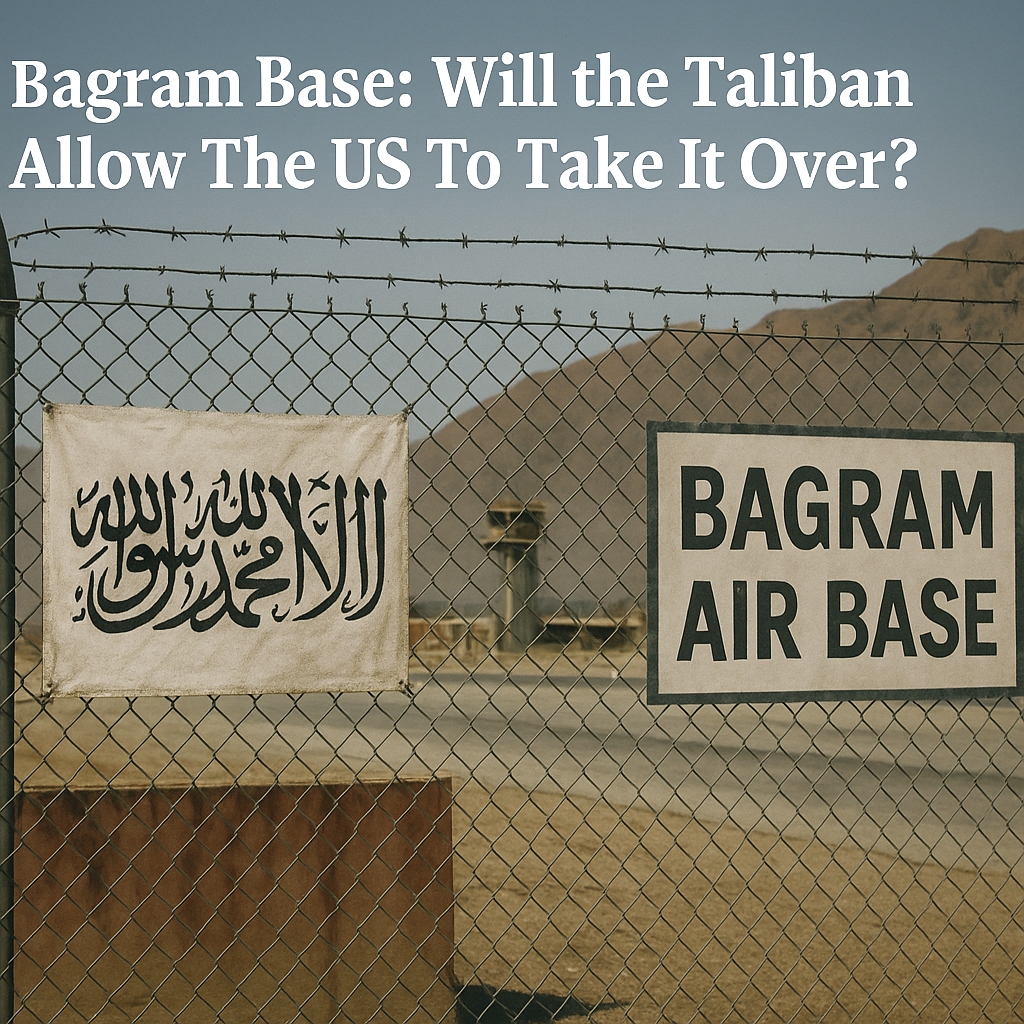



 Omar Ahmed
Omar Ahmed
US President Donald Trump has made no secret of his intentions to see American troops once again entrenched in the Bagram Airbase. His belligerence has now reached the point where he posted on Truth Social:
“If Afghanistan doesn’t give Bagram Airbase back to those that built it, the United States of America, BAD THINGS ARE GOING TO HAPPEN!!!”
Quite aside from Trump’s false claim, this external bullying shows the enduring significance of Bagram, the prize every major aggressor covets when seeking control over Central and West Asia.
With the recent spike in hostilities between Pakistan and Afghanistan escalating to unprecedented levels, the discussion surrounding the Bagram Airbase has popped up once more. Since returning to power, the Taliban have adamantly refused to host any foreign military forces on Afghan soil. But could immense pressure, particularly amid Pakistan’s escalating attacks, compel concessions?
Geostrategic importance
Some 60 kilometers north of Kabul, in Parwan Province, lies the Bagram Airbase—a vast installation nestled at 1,500 meters above sea level, commanding the crossroads of West Asia, South Asia, and Central Asia. Constructed in the 1950s by the Afghan monarchy and expanded in the 1970s under General Mohammad Daoud Khan’s ambitious modernization effort, Bagram rapidly drew foreign interest.
Soviet support transformed it into a key node of the USSR’s military thrust into Afghanistan. After Daoud’s overthrow in April 1978, the pro-Soviet regime allowed the base to become synonymous with the Red Army’s occupation. It served as the primary staging ground for bombardments of Mujahideen positions, housing fighter-bombers, gunships, and large-scale logistics.
From a geopolitical standpoint, Bagram represented the Soviet Union’s determination to control the regional balance and defend its southern frontier during the Cold War.
Additionally, it was a component of the USSR’s strategic southward thrust, affording it leverage against Pakistan, which was then acting as a haven and supply line for militants backed by the CIA.
Its position — monitoring Iran, Pakistan, western China, and the Central Asian republics—grants it a strategic potency few installations on earth can match. Its fortification, scale, and infrastructure built up over decades make it one of the most militarized foreign hubs in modern history, once allowing domination of Afghan skies and deep surveillance into neighbouring territories.
Following the October 2001 US invasion of Afghanistan, the base was further expanded into Washington’s principal imperial launchpad in the region. At its height, over 30,000 foreign troops were stationed there serving as the focal point of NATO’s International Security Assistance Force (ISAF) activities.
American drone operations across Afghanistan and Pakistan, interrogation programmes, and the notorious Parwan Detention Facility were all centred here.
Bagram offered Washington permanent eyes and claws on China, Iran, and resistance movements in the region. It was the anchor of US power projection after 9/11—which explains why Trump’s obsession persists.
Symbolic value for the Taliban and objections from other states
When the Taliban retook power in August 2021, they inherited Bagram for the first time since 2001. Though now largely quiet, its symbolic weight is enormous. To the Taliban and Afghans more broadly, Bagram represents liberation from occupation—the severing of a two-decade chain of foreign domination.
Control of Bagram by outsiders was, for Afghans, synonymous with torture, raids, humiliation, and subjugation. During the resistance, Taliban messaging often described it as “the fortress of the invaders” and the beating heart of foreign tyranny. The mere recapture of this base served as a legitimising achievement for their Islamic governance.
The propaganda value of the Taliban coming to control this staging ground of foreign occupiers is hard to underestimate. That is why Taliban leadership, even though they may be willing to reopen embassies with the US, deny any possibility of handing it over to any outside power. According to Zabihullah Mujahid, who was interviewed by Sky News, “Afghans will never allow their land to be handed over to anyone under any circumstances.”
The base has also been integrated into the Taliban’s state-building narrative. Official visits by defence officials are prominently broadcast to show that Afghanistan—not foreign troops— now guards the country’s airspace and strategic infrastructure.
Meanwhile, China and Russia have signalled interest in limited security or logistical cooperation through Bagram under Afghan control—as part of regional initiatives like the Belt and Road Initiative (BRI) or counterterrorism frameworks. While no such plans have advanced meaningfully, the mere possibility unsettles Washington.
Even though it is no longer used as a base for extensive operations, its presence nonetheless influences how important regional actors interact with the Taliban administration and Afghanistan’s changing strategic environment.
Friendship with India, enmity with Pakistan, crisis for Afghanistan?
Tensions between Pakistan and Afghanistan escalated dramatically in early October, as Islamabad again accused the Taliban government of harbouring Tehreek-e-Taliban Pakistan (TTP) militants operating across the border. The situation shifted from rhetoric to overt confrontation.
Explosions struck Kabul on October 9-10, including one near key government sites in Abdul Haq Square. Kabul publicly accused Pakistan of conducting airstrikes across the capital and in Paktika province near the Durand Line.
Calling these strikes “unprecedented, violent, and heinous,” Afghanistan denounced them as an infringement of its sovereignty.
Heavy fighting broke out along the Pakistan-Afghanistan border after those strikes. Both sides exchanged claims over who started the violence between October 11 and 12. The Pakistani military responded by claiming that it carried out operations, destroyed many militant training centers, temporarily seized border posts, and repulsed these attacks.
Pakistan’s attacks on Kabul and in Paktika sparked retaliatory actions, Afghanistan’s side retorted. Kabul also claimed to have captured guns, taken over Pakistani border posts, and killed Pakistani forces. Both sides have reported casualties but the numbers are disputed. It is a far cry from four years ago when the generals in Rawalpindi claimed Afghanistan was their “strategic depth”.
The Taliban government openly condemned what it said was Pakistani drone and airstrikes as violations of Afghan sovereignty and airspace amid the escalating violence. Pakistan said its actions were defensive and in response to repeated cross-border attacks and unwarranted aggression, even though it acknowledged the threat posed by militant safe havens.
Then, amid this intensified conflict, Pakistan allegedly conducted airstrikes in the provinces of Kabul and Kandahar on October 15.
These incidents followed closely after the warming of ties between India and Afghanistan. The Taliban government’s foreign minister, Amir Khan Muttaqi, travelled to New Delhi on October 9 for a one-week visit. Since the Taliban regained power, this was the first time a senior Taliban official had visited India at such a high level.
India declared during the visit that it would open a full-fledged embassy in Kabul, replacing its “technical mission,” which has operated since around 2022. Following the Taliban takeover, India closed its embassy in 2021, but it maintained some limited contact through a technical staff that handled trade, humanitarian assistance, and medical collaboration.
To Islamabad’s security establishment, which accuses India of backing the TTP, this diplomatic shift is provocative. Pakistan’s timing —launching strikes days after the Taliban delegation arrived in Delhi—has therefore raised suspicions.
Simultaneously, Pakistan’s warming ties with Washington under Trump add another layer of intrigue. The assumption that TTP activities alone triggered such escalatory strikes appears inadequate when viewed against broader US strategic frustrations over losing Bagram.
This raises the obvious question:
Is Pakistan applying military pressure to force the Taliban into allowing a renewed US foothold at Bagram — even if under the guise of “joint counterterrorism”?
The Taliban today govern a state rather than command a guerrilla movement. They must defend territory, civilians, and infrastructure—a burden the US exploited against previous Afghan governments.
Whether the confrontation escalates again into full-scale conflict—and whether the Taliban’s resolve remains intact—remains to be seen. Incentives dangled by the US, from frozen-asset relief to diplomatic recognition, may yet be deployed as leverage. China and Russia may also counter-balance any pressure campaign, refusing to allow the region to fall back under direct US military surveillance.
But if Washington and its allies are hoping to break the Taliban psychologically, they may be misreading their target. The movement is built—from top to bottom—by men forged in hardship, who fought superpowers for decades without surrender.
Bagram serves a reminder of victory over occupiers. And that is not something the Taliban are likely to relinquish at the first sign of coercion.
